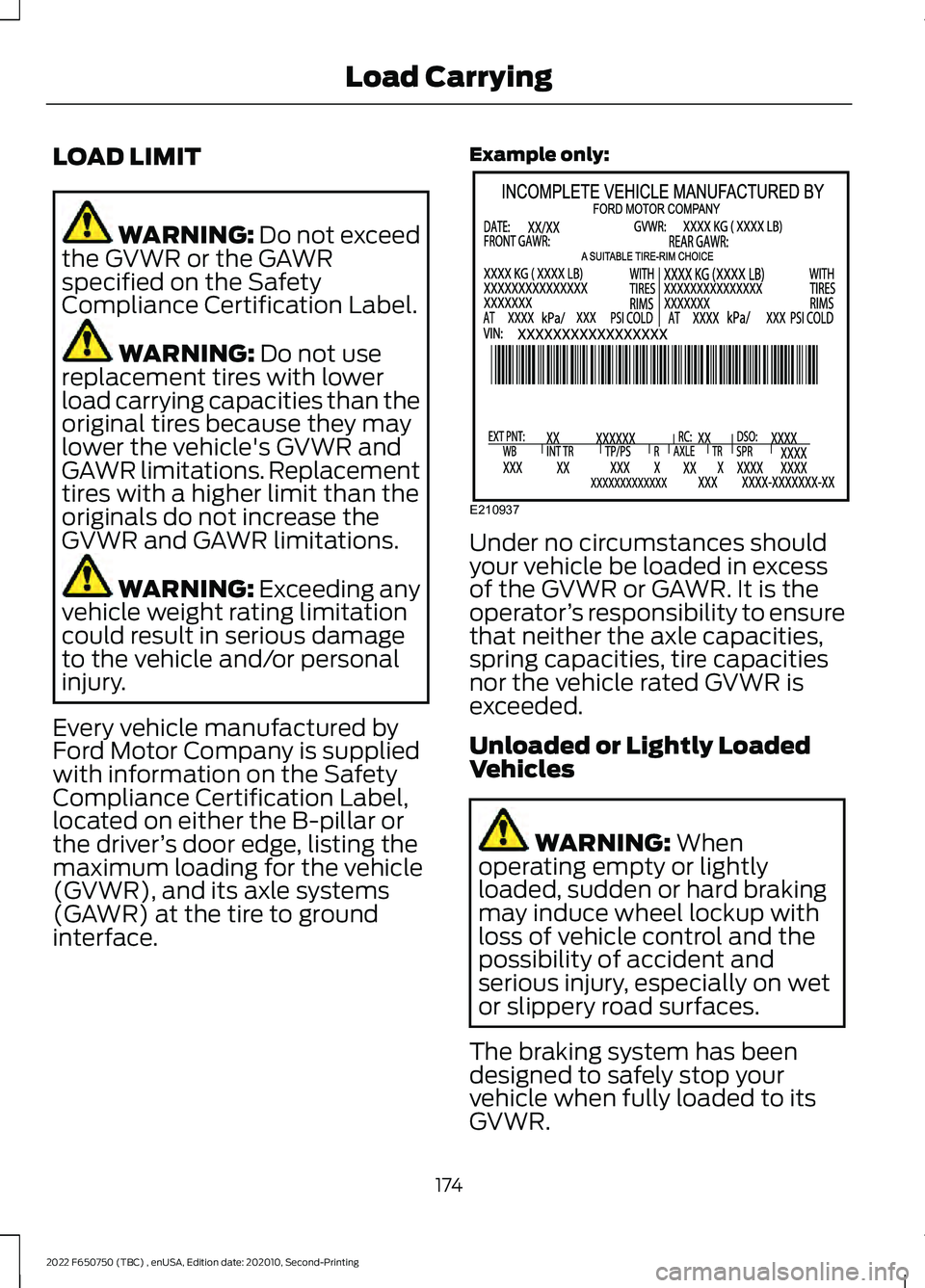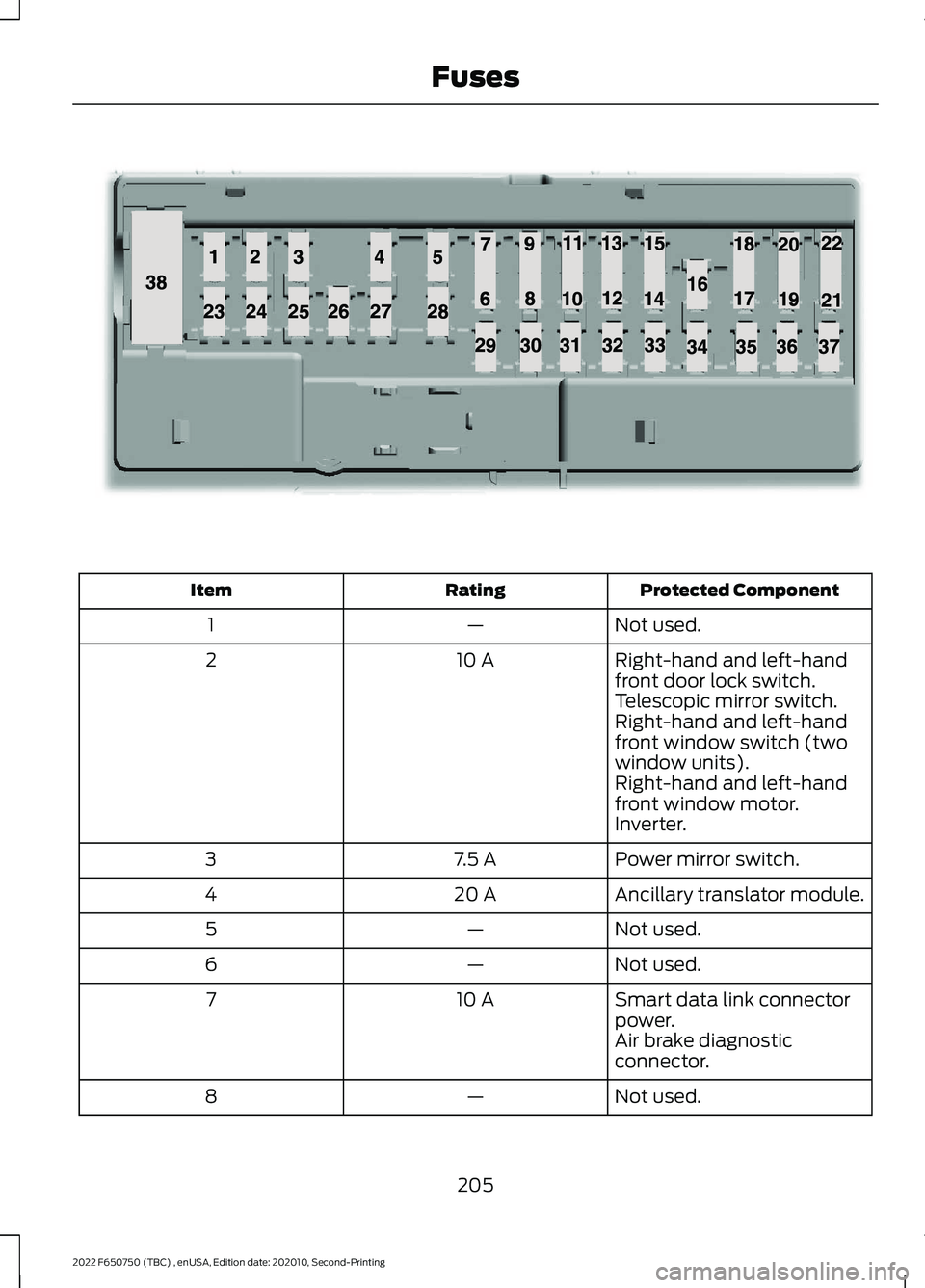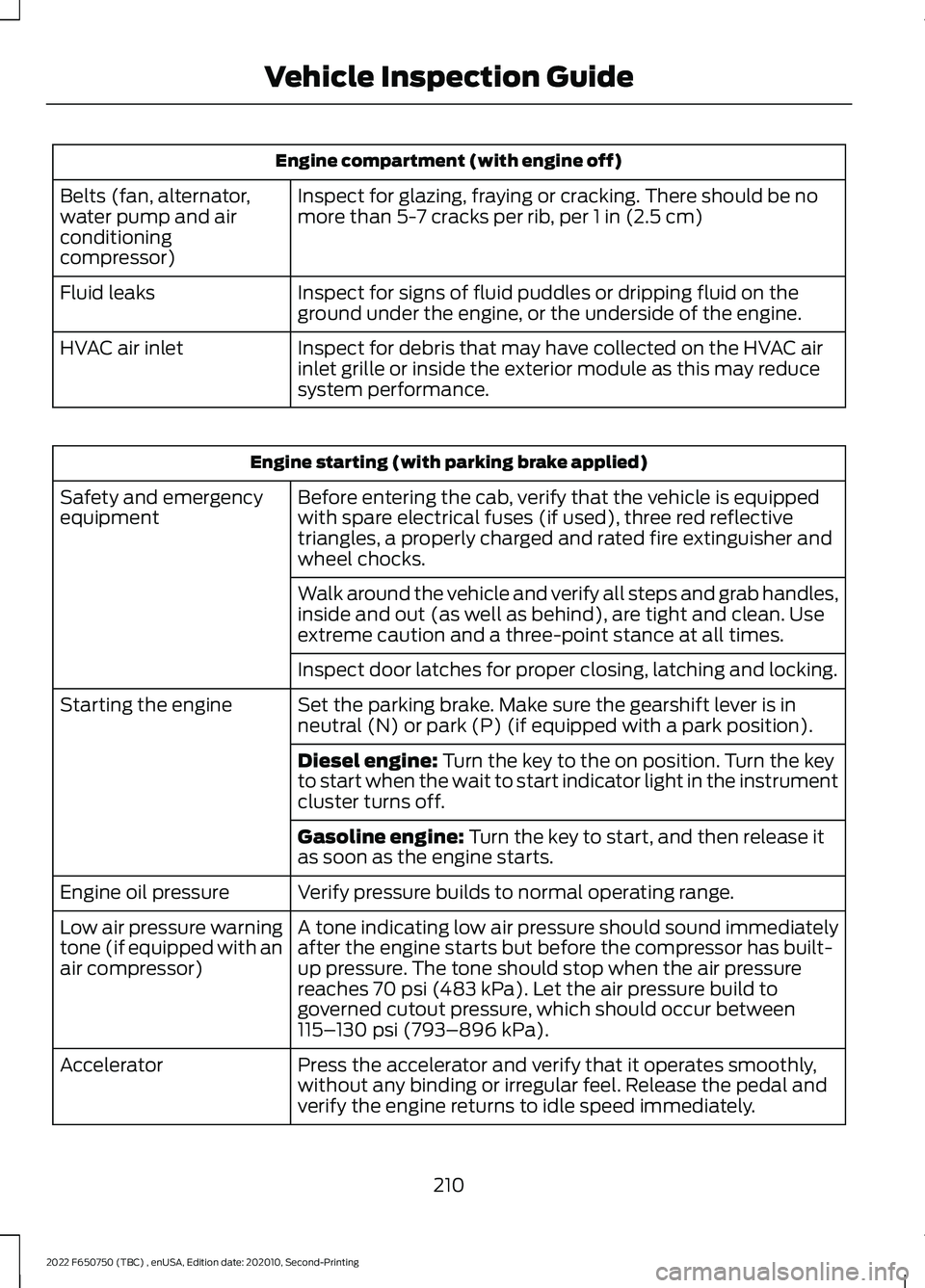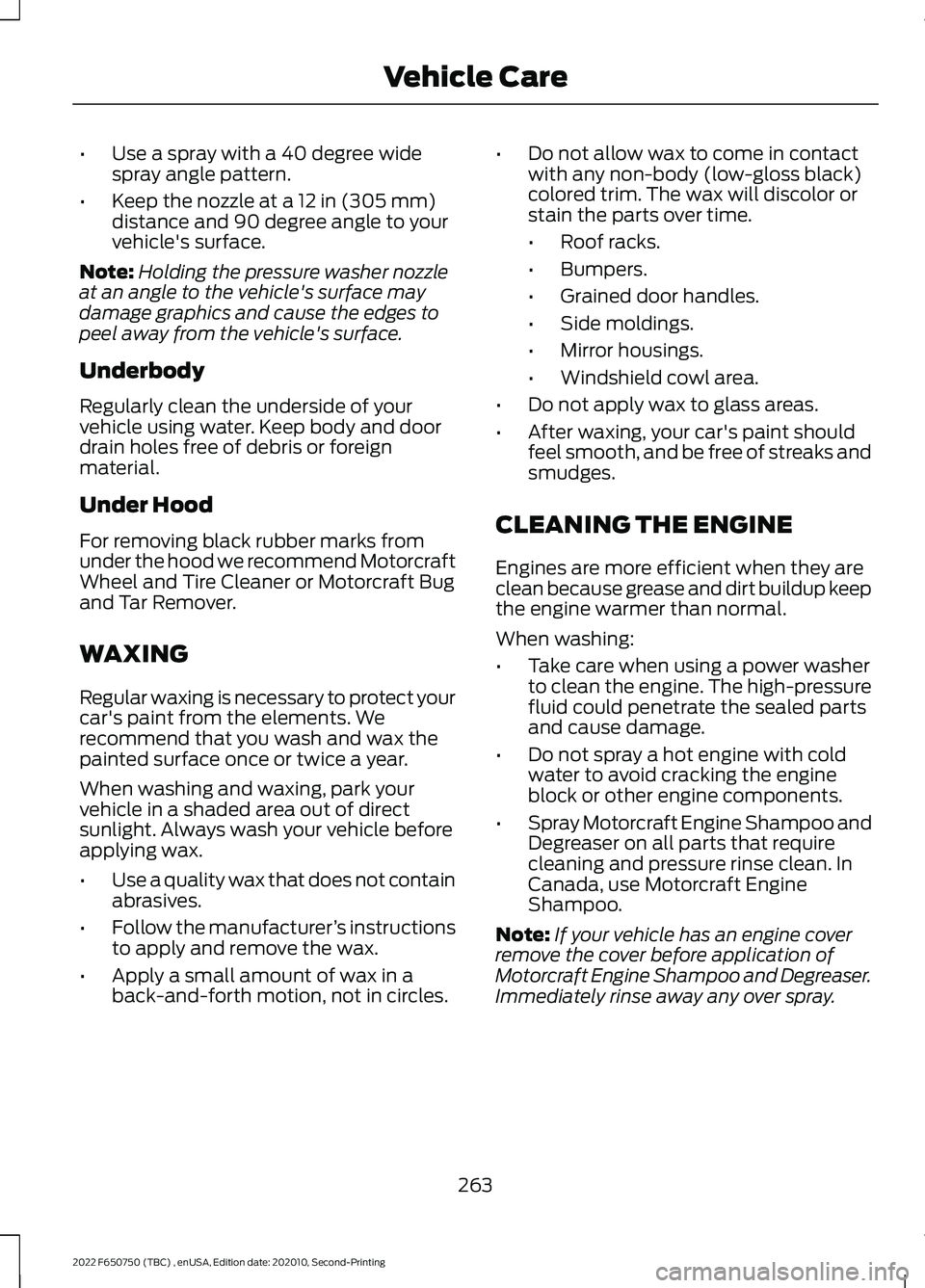2022 FORD F-650/750 door lock
[x] Cancel search: door lockPage 177 of 379

LOAD LIMIT
WARNING: Do not exceed
the GVWR or the GAWR
specified on the Safety
Compliance Certification Label. WARNING:
Do not use
replacement tires with lower
load carrying capacities than the
original tires because they may
lower the vehicle's GVWR and
GAWR limitations. Replacement
tires with a higher limit than the
originals do not increase the
GVWR and GAWR limitations. WARNING: Exceeding any
vehicle weight rating limitation
could result in serious damage
to the vehicle and/or personal
injury.
Every vehicle manufactured by
Ford Motor Company is supplied
with information on the Safety
Compliance Certification Label,
located on either the B-pillar or
the driver ’s door edge, listing the
maximum loading for the vehicle
(GVWR), and its axle systems
(GAWR) at the tire to ground
interface. Example only:
Under no circumstances should
your vehicle be loaded in excess
of the GVWR or GAWR. It is the
operator
’s responsibility to ensure
that neither the axle capacities,
spring capacities, tire capacities
nor the vehicle rated GVWR is
exceeded.
Unloaded or Lightly Loaded
Vehicles WARNING:
When
operating empty or lightly
loaded, sudden or hard braking
may induce wheel lockup with
loss of vehicle control and the
possibility of accident and
serious injury, especially on wet
or slippery road surfaces.
The braking system has been
designed to safely stop your
vehicle when fully loaded to its
GVWR.
174
2022 F650750 (TBC) , enUSA, Edition date: 202010, Second-Printing Load CarryingE210937
Page 208 of 379

Protected Component
Rating
Item
Not used.
—
1
Right-hand and left-hand
front door lock switch.
10 A
2
Telescopic mirror switch.
Right-hand and left-hand
front window switch (two
window units).
Right-hand and left-hand
front window motor.
Inverter.
Power mirror switch.
7.5 A
3
Ancillary translator module.
20 A
4
Not used.
—
5
Not used.
—
6
Smart data link connector
power.
10 A
7
Air brake diagnostic
connector.
Not used.
—
8
205
2022 F650750 (TBC) , enUSA, Edition date: 202010, Second-Printing FusesE145984
Page 213 of 379

Engine compartment (with engine off)
Inspect for glazing, fraying or cracking. There should be no
more than 5-7 cracks per rib, per 1 in (2.5 cm)
Belts (fan, alternator,
water pump and air
conditioning
compressor)
Inspect for signs of fluid puddles or dripping fluid on the
ground under the engine, or the underside of the engine.
Fluid leaks
Inspect for debris that may have collected on the HVAC air
inlet grille or inside the exterior module as this may reduce
system performance.
HVAC air inlet Engine starting (with parking brake applied)
Before entering the cab, verify that the vehicle is equipped
with spare electrical fuses (if used), three red reflective
triangles, a properly charged and rated fire extinguisher and
wheel chocks.
Safety and emergency
equipment
Walk around the vehicle and verify all steps and grab handles,
inside and out (as well as behind), are tight and clean. Use
extreme caution and a three-point stance at all times.
Inspect door latches for proper closing, latching and locking.
Set the parking brake. Make sure the gearshift lever is in
neutral (N) or park (P) (if equipped with a park position).
Starting the engine
Diesel engine:
Turn the key to the on position. Turn the key
to start when the wait to start indicator light in the instrument
cluster turns off.
Gasoline engine:
Turn the key to start, and then release it
as soon as the engine starts.
Verify pressure builds to normal operating range.
Engine oil pressure
A tone indicating low air pressure should sound immediately
after the engine starts but before the compressor has built-
up pressure. The tone should stop when the air pressure
reaches
70 psi (483 kPa). Let the air pressure build to
governed cutout pressure, which should occur between
115– 130 psi (793–896 kPa)
.
Low air pressure warning
tone (if equipped with an
air compressor)
Press the accelerator and verify that it operates smoothly,
without any binding or irregular feel. Release the pedal and
verify the engine returns to idle speed immediately.
Accelerator
210
2022 F650750 (TBC) , enUSA, Edition date: 202010, Second-Printing Vehicle Inspection Guide
Page 249 of 379

5. Turn the air conditioning (if equipped)
on and allow the engine to idle for at
least one minute.
6. Release the parking brake. With your foot on the brake pedal and with the
air conditioning on, put the vehicle in
drive (D) and allow the engine to idle
for at least one minute.
•If you do not allow the engine to
relearn its idle trim, the idle quality
of your vehicle may be adversely
affected until the idle trim is
eventually relearned.
7. Drive the vehicle to complete the relearning process
•The vehicle may need to be driven
10 mi (16 km) or more to relearn the
idle and fuel trim strategy along
with the ethanol content for flexible
fuel vehicles.
If the battery has been disconnected or a
new battery has been installed, the clock
and radio settings must be reset once the
battery is reconnected.
Always dispose of automotive
batteries in a responsible manner.
Follow your local authorized standards
for disposal. Call your local authorized
recycling center to find out more about
recycling automotive batteries.
Battery Management System (If
Equipped)
The battery management system (BMS)
monitors battery conditions and takes
actions to extend battery life. If excessive
battery drain is detected, the system may
temporarily disable certain electrical
features to protect the battery. Those
electrical accessories affected include the
rear defrost, heated/cooled seats, climate
control fan, heated steering wheel, audio
and navigation system. A message may be
shown in the information displays to alert the driver that battery protection actions
are active. These messages are only for
notification that an action is taking place,
and not intended to indicate an electrical
problem or that the battery requires
replacement.
Electrical accessory installation
To ensure proper operation of the BMS,
any electrical devices that are added to
the vehicle should not have their ground
connection made directly at the negative
battery post. A connection at the negative
battery post can cause inaccurate
measurements of the battery condition
and potential incorrect system operation.
Note:
Electrical or electronic accessories
added to the vehicle by the dealer or the
owner may adversely affect battery
performance and durability, and may also
affect the performance of other electrical
systems in the vehicle.
When a battery replacement is required,
the battery should only be replaced with
a Ford recommended replacement battery
which matches the electrical requirements
of the vehicle. After battery replacement,
or in some cases after charging the battery
with the external charger, the BMS requires
eight hours of vehicle sleep time (key off
with doors closed) to relearn the new
battery state of charge. Prior to relearning
the state of charge, the BMS may disable
electrical features (to protect the battery)
earlier than normal.
ADJUSTING THE HEADLAMPS
Vertical Aim Adjustment
The headlamps on your vehicle are
properly aimed at the assembly plant. If
your vehicle has been in an accident, the
alignment of your headlamps should be
checked by your authorized dealer.
246
2022 F650750 (TBC) , enUSA, Edition date: 202010, Second-Printing Maintenance
Page 266 of 379

•
Use a spray with a 40 degree wide
spray angle pattern.
• Keep the nozzle at a 12 in (305 mm)
distance and 90 degree angle to your
vehicle's surface.
Note: Holding the pressure washer nozzle
at an angle to the vehicle's surface may
damage graphics and cause the edges to
peel away from the vehicle's surface.
Underbody
Regularly clean the underside of your
vehicle using water. Keep body and door
drain holes free of debris or foreign
material.
Under Hood
For removing black rubber marks from
under the hood we recommend Motorcraft
Wheel and Tire Cleaner or Motorcraft Bug
and Tar Remover.
WAXING
Regular waxing is necessary to protect your
car's paint from the elements. We
recommend that you wash and wax the
painted surface once or twice a year.
When washing and waxing, park your
vehicle in a shaded area out of direct
sunlight. Always wash your vehicle before
applying wax.
• Use a quality wax that does not contain
abrasives.
• Follow the manufacturer ’s instructions
to apply and remove the wax.
• Apply a small amount of wax in a
back-and-forth motion, not in circles. •
Do not allow wax to come in contact
with any non-body (low-gloss black)
colored trim. The wax will discolor or
stain the parts over time.
•Roof racks.
• Bumpers.
• Grained door handles.
• Side moldings.
• Mirror housings.
• Windshield cowl area.
• Do not apply wax to glass areas.
• After waxing, your car's paint should
feel smooth, and be free of streaks and
smudges.
CLEANING THE ENGINE
Engines are more efficient when they are
clean because grease and dirt buildup keep
the engine warmer than normal.
When washing:
• Take care when using a power washer
to clean the engine. The high-pressure
fluid could penetrate the sealed parts
and cause damage.
• Do not spray a hot engine with cold
water to avoid cracking the engine
block or other engine components.
• Spray Motorcraft Engine Shampoo and
Degreaser on all parts that require
cleaning and pressure rinse clean. In
Canada, use Motorcraft Engine
Shampoo.
Note: If your vehicle has an engine cover
remove the cover before application of
Motorcraft Engine Shampoo and Degreaser.
Immediately rinse away any over spray.
263
2022 F650750 (TBC) , enUSA, Edition date: 202010, Second-Printing Vehicle Care
Page 327 of 379

Check Every Month
Tires (including spare) for wear and proper pressure. Windshield washer fluid level.
1 Diesel engine only. Check Every Six Months
Battery connections. Clean if necessary.
Body and door drain holes for obstructions. Clean if necessary.
Cooling system fluid level and coolant concentration (freeze-point protection). Door weatherstrips for wear. Lubricate if necessary.
Hinges, latches and outside locks for proper operation. Lubricate if necessary. Parking brake for proper operation.
Safety belts and seat latches for wear and function.
Safety warning lamps (brake, ABS, airbag and safety belt) for operation.
Washer spray and wiper operation. Clean or replace blades as necessary. Tightening Lug Nuts
Tighten the lug nuts to the specified torque 1
at 500 mi
(800 km) after any wheel disturbance (such as tire rota-
tion, changing a flat tire or wheel removal).
Single rear wheels
Tighten the wheel lug nuts to the specified torque 1
at
100 mi (160 km)
, and again at 500 mi (800 km) of new
vehicle operation and after any wheel disturbance (such as tire rotation, changing a flat tire or wheel removal).
Dual rear wheels
1 See
Technical Specifications (page 285).
324
2022 F650750 (TBC) , enUSA, Edition date: 202010, Second-Printing Scheduled Maintenance
Page 375 of 379

Child Safety......................................................24
General Information............................................ 24
Child Safety Locks
.........................................35
Cleaning Products........................................261
Cleaning the Engine....................................263
Cleaning the Exterior..................................262
Cleaning the Instrument Panel and Instrument Cluster Lens........................265
Cleaning the Interior...................................264
Cleaning the Wheels..................................265
Cleaning the Windows and Wiper Blades...........................................................264
Climate Control
..............................................85
Cold Weather Precautions........................183
Connected Vehicle.....................................306
Connected Vehicle –
Troubleshooting............................................ 307
Connecting the Vehicle to a Mobile Network - Vehicles With: Modem............................ 306
Connected Vehicle Limitations..............306
Connected Vehicle Requirements
........306
Connected Vehicle – Troubleshooting........................................307
Connected Vehicle – Frequently Asked Questions......................................................... 307
Connecting a Bluetooth® Device...........313
Connecting the Vehicle to a Mobile Network - Vehicles With:
Modem.........................................................306
Connecting FordPass to the Modem.........306
Enabling and Disabling the Modem..........306
What Is the Modem..........................................306
Coolant Check See: Engine Coolant Check - 6.7L
Diesel................................................................. 232
See: Engine Coolant Check - 7.3L.................237
Cooling System Capacity and Specification - 6.7L Diesel.....................295
Cooling System Capacity and Specification - 7.3L..................................296
Cruise Control
................................................154
Cruise Control Indicators............................161
Cruise Control - Vehicles With: Adaptive Cruise Control................................................51
Cruise Control - Vehicles With: Cruise Control..............................................................51
Customer Assistance
..................................193 Customer Information...............................340
Radio Frequency Certification
Labels............................................................... 340
D
Data Recording
.................................................13
Daytime Running Lamps - Vehicles With: Configurable Daytime Running
Lamps.............................................................56
Daytime Running Lamps - Vehicles With: Daytime Running Lamps (DRL)............56
Diesel Exhaust Fluid Capacity and Specification..............................................300
Diesel Particulate Filter...............................122
Digital Radio....................................................311
Direction Indicators........................................57
Doors and Locks.............................................48
Draining the Fuel Filter Water Trap - 6.7L Diesel..............................................................231
Driver Alert
......................................................162
Driving Aids.....................................................162
Driving Hints...................................................182
Driving Through Water...............................186
DRL See: Daytime Running Lamps - Vehicles With:
Configurable Daytime Running
Lamps.................................................................. 56
See: Daytime Running Lamps - Vehicles With: Daytime Running Lamps (DRL)................56
E
Economical Driving
......................................183
Electrical System Inspection...................253
Electromagnetic Compatibility..............345
Electronic Locking Differential................134
Emission Law..................................................115
End User License Agreement.................348
Engine Block Heater....................................104
Engine Coolant Check - 6.7L Diesel.............................................................232
Engine Coolant Check - 7.3L....................237
Engine Emission Control
.............................115
Engine Idle Shutdown................................103
Engine Immobilizer See: Passive Anti-Theft System.....................50
372
2022 F650750 (TBC) , enUSA, Edition date: 202010, Second-Printing Index
Page 377 of 379

Installing Child Restraints...........................26
Instrument Cluster.........................................63
Instrument Lighting Dimmer.....................55
Instrument Panel
............................................23
Interior Lamps.................................................58
Interior Mirror...................................................62
Introduction.........................................................7
J
Jump Starting the Vehicle.........................189
K
Keys and Remote Controls.........................45
L
Lane Keeping System.................................163
Lighting Control
..............................................54
Lighting..............................................................54
General Information............................................ 54
Load Carrying
..................................................174
Load Limit........................................................174
Locating the USB Ports................................97
Locking and Unlocking
................................48
Lug Nuts See: Changing a Road Wheel....................... 283
M
Maintenance..................................................218 General Information.......................................... 218
Manual Climate Control..............................85
Manual Seats..................................................90
Message Center See: Information Displays................................. 70
Mirrors See: Windows and Mirrors................................ 59
Mobile Communications Equipment......19
Motorcraft Parts - 6.7L Diesel.................288
Motorcraft Parts - 7.3L...............................289
N
Noise Pollution Control.................................21
Normal Scheduled Maintenance
...........325 O
Oil Change Indicator Reset
......................226
Oil Check See: Engine Oil Check - 6.7L Diesel.............223
See: Engine Oil Check - 7.3L........................... 224
Opening and Closing the Hood...............219
Ordering Additional Owner's Literature.......................................................197
Overhead Console
.........................................99
P
Parking Brake..................................................137
Passive Anti-Theft System
........................50
PATS See: Passive Anti-Theft System.....................50
Perchlorate.........................................................17
Playing Media From a USB Device.........314
Playing Media Using the USB Port...........97
Power Door Locks See: Locking and Unlocking............................. 48
Power Seats......................................................91
Power Steering Fluid Check
.....................244
Power Take-Off.............................................133
Power Windows..............................................59
Pre-Collision Assist - Vehicles With: Air Brakes.............................................................167
Pre-Collision Assist - Vehicles With: Hydraulic Brakes
........................................169
Protecting the Environment........................21
Puncture See: Changing a Road Wheel....................... 283
R
Radio Frequency Certification Labels...........................................................340
Cruise Control Module..................................... 340
Rear Axle Fluid Capacity and Specification - Diesel..............................302
Rear Axle Fluid Capacity and Specification - Gasoline
........................303
Rear Axle Fluid Check................................259
Rear Axle
..........................................................134
General Information.......................................... 134
Rear Seat Armrest.........................................94
Rear Seats.........................................................93
374
2022 F650750 (TBC) , enUSA, Edition date: 202010, Second-Printing Index